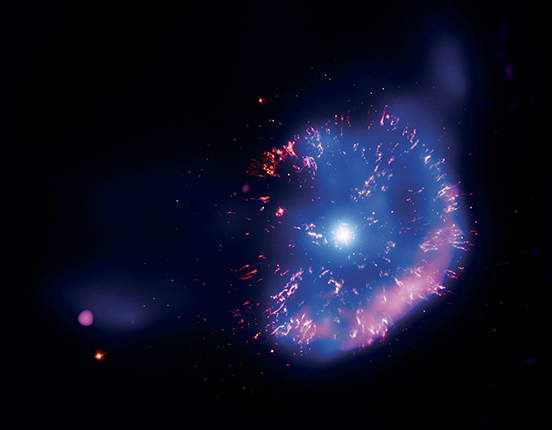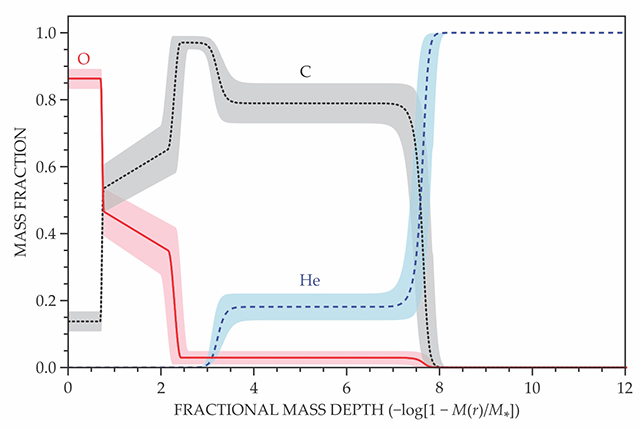Asteroseismology reveals the structure of a white dwarf
DOI: 10.1063/PT.3.3862
NASA’s Kepler space observatory, which has circled the Sun for nearly nine years in an Earth-trailing orbit, is best known as a planet hunter. By observing variations in the brightness of the 150 000 stars in its fixed field of view, it can detect the telltale periodic dimming caused by transiting exoplanets. But Kepler’s observations are also a treasure trove for asteroseismologists, who analyze stars’ intrinsic pulsations to tease out the physical properties of stellar interiors. Such studies have yielded precise estimates of stellar masses, temperatures, and internal rotation speeds. (See the article by Conny Aerts, Physics Today, May 2015, page 36.
Now Noemi Giammichele and her coworkers at the University of Toulouse in France and the University of Montreal have used asteroseismology to peer into the heart of a white dwarf—a star in the slow cooling phase that marks the end of the life cycle of all but the most massive stars. Giammichele and her colleagues analyzed nearly two years of Kepler data on the white dwarf KIC 08626021 to find out how the remnants of bygone nuclear burning—helium, carbon, and oxygen—had mixed and settled in the star’s interior. 1 Their results, which reconstruct the star’s composition with unprecedented detail, confirm the broad contours of stellar evolution theory but significantly challenge the particulars.
A star grows old
Stellar evolution theory tells us that billions of years ago, KIC 08626021 was a fiery hydrogen furnace much like our current sun. It was powered at its hot, dense core by the fusion of hydrogen into helium; a surrounding shell of hydrogen remained too cool to react. When the hydrogen in the core was depleted, the core extinguished, contracted under the star’s weight, and, in the process, grew hot enough to ignite the helium that had amassed during the preceding round of fusion.

A white dwarf undergoing a nova explosion, as observed by NASA’s Chandra X-Ray Observatory. The internal structure of a white dwarf preserves a record of the thermonuclear and mixing processes that prevailed over its lifetime. Using asteroseismology, researchers have now teased out that structure for one white dwarf, KIC 08626021.
NASA/CHANDRA X-RAY OBSERVATORY

At that point, a rich internal stellar structure began to develop. The core helium fused into carbon, some of which snapped up additional helium nuclei to form oxygen. The resulting heat ignited previously dormant hydrogen in the regions surrounding the core. As fusion products settled and convective currents shuttled material between reaction zones, the star’s chemical profile grew even more complex.
By the time KIC 08626021’s nuclear fires quelled, about 8 million years ago, the star’s contents had organized into several layers, each with its own distinct blend of carbon, oxygen, and helium. (The outer shell of hydrogen had been blown away in a final nuclear flare-up.) Stellar evolution models can’t tell us the precise nature of those layers. But, in principle, the star’s pulsations, manifested as brightness fluctuations, can.
The luminosities of KIC 08626021 and other pulsating white dwarfs are modulated by gravity waves, buoyancy-driven density fluctuations that continually course through the stars’ interiors. Like a ringing bell, a star can pulsate with many resonant gravity-wave modes, or g modes, at once. Since the periods of those modes depend on the internal profile of thermodynamic properties such as density and heat capacity, some of the g modes carry information about the star’s internal stratification.
But the effects due to chemical composition are subtle, particularly deep in the stellar interior. In the early 2000s, when a group of astronomers attempted to determine a white dwarf’s structure using data from the ground-based Whole Earth Telescope, the results were ambiguous. 2 It wasn’t until the advent of the space-based Kepler, with its clear, continuous view of the cosmos, that astronomers could hope to observe pulsations with the sensitivity and precision needed to reliably map out stellar interiors.

The chemical profile of the white dwarf KIC 08626021, revealed by asteroseismology. Roughly half the mass of our sun, the star is oxygen- and carbon-rich at its center and helium-rich at its periphery, in agreement with stellar evolution theory. (Radial distance increases with fractional mass depth.) But the oxygen mass fraction—more than 85% at the stellar center—is too large to be accounted for by current theories. Here, M* is the white dwarf’s mass, M(r) is the mass within radius r, and shaded regions correspond to 1σ confidence intervals. (Adapted from ref.

Simulating starquakes
About the size of Earth and more than 1000 light-years away, KIC 08626021 appears as just a single pixel in the 95-megapixel images captured by Kepler’s onboard camera. Even so, the nearly two-year light curve obtained from that pixel contains a bounty of information. In all, it revealed eight g modes with oscillation periods ranging from two to seven minutes. Those periods could be resolved with microsecond precision—orders of magnitude better than measurements in previous asteroseismic studies.
To translate the observations into information about the stellar interior, one typically uses a forward seismic model, which takes a set of adjustable input parameters characterizing a star’s physical properties and predicts how the star will pulsate over time. When Kepler’s data began rolling in, Stéphane Charpinet of Toulouse and Gilles Fontaine of Montreal had already been collaborating on such models for more than a decade. 3 But, like other asteroseismology models, theirs described stellar structure in coarse terms. They assumed, for instance, that the stellar interior was not layered but uniformly mixed. The models typically took just four or five input parameters—any more and the numerical algorithms could misbehave.
When Giammichele joined Fontaine’s group as a graduate student, she used techniques from computational aerodynamics to equip the models for handling the additional parameters required to describe a star’s layered composition. Because the new model has more than a dozen adjustable parameters but Kepler identified just eight of KIC 08626021’s g-mode periods, it isn’t theoretically guaranteed to produce a unique solution. In trial runs on hypothetical stars, however, the researchers showed that even in some cases where only five g modes are known, the model yields a solution that can be numerically verified as unique.
“But the star has to cooperate,” says Giammichele. That is, the detected g modes should each probe different regions and provide complementary information about the stellar interior. It’s helpful, for instance, if the observed pulsations include both dipole and quadrupole g modes; many stars exhibit only one or the other. KIC 08626021, one of just six white dwarfs detected during Kepler’s initial four-year run, turned out to be cooperative.
Devil in the details
When Giammichele and her coworkers applied their asteroseismic model to KIC 08626021, the results, shown in the
It’s in the particulars of that profile that the asteroseismology result and stellar evolution theory disagree. In the asteroseismic model, the star’s center is more than 85% oxygen—some 15% more than predicted by leading stellar evolution models. The oxygen-to-carbon ratio, averaged over the entire star, is nearly four to one; stellar evolution models predict a two-to-one ratio.
The overabundance of oxygen suggests that somehow the chain of reactions that powered the star during its helium-burning phase progressed further than stellar evolution theory predicts—either because the theory underestimates the carbon-to-oxygen reaction rate or because mixing processes are unexpectedly efficient at replenishing the burning core with fresh helium.
“Stellar evolution theory has to be missing something,” says Conny Aerts of the University of Leuven in Belgium. “The theory that for the past 30 years we thought was great is actually not good enough.”
An improved understanding of white-dwarf structure could help refine methods for estimating the stars’ ages and help astronomers more accurately interpret the light curves of type 1a supernovae, the violent explosions that occur when a matter-accreting white dwarf surpasses a critical mass. But how much can one infer from a single study of a single star?
The question may soon be rendered moot. Kepler’s follow-up mission, K2, initiated in 2014, is finding pulsating white dwarfs at a furious pace. “K2 is a gold mine,” says Giammichele. “There are already something like 60 white dwarfs that I can analyze. I’m not saying every one of them will give results, but a good portion of them, yes, they’re cooperating.”
References
1. N. Giammichele et al., Nature 554, 73 (2018). https://doi.org/10.1038/nature25136
2. T. S. Metcalfe, D. E. Winget, P. Charbonneau, Astrophys. J. 557, 1021 (2001). https://doi.org/10.1086/321643
3. S. Charpinet et al., Astrophys. J. Lett. 471, L103 (1996). https://doi.org/10.1086/310335
